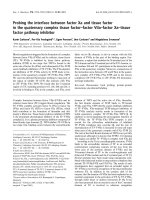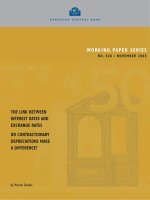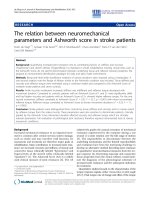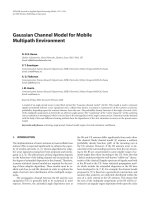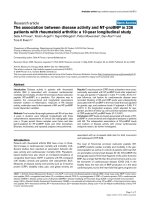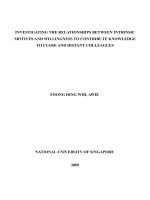investigating the link between smart cities and environmental protection in vietnam
Bạn đang xem bản rút gọn của tài liệu. Xem và tải ngay bản đầy đủ của tài liệu tại đây (808.17 KB, 18 trang )
<span class="text_page_counter">Trang 1</span><div class="page_container" data-page="1">
<b>111Equation Chapter 1 Section 1 </b>BỘ GIÁO DỤC VÀ ĐÀO TẠO
<b>ĐẠI HỌC BÁCH KHOA HÀ NỘI</b>
Nhóm sinh viên thực hiện:
Giáo viên hướng dẫn: TS Thái Minh Hạnh TS Hà Thị Thư Trang
<b>Hà Nội, tháng 5 - 2023</b>
Click here to enter text.
</div><span class="text_page_counter">Trang 2</span><div class="page_container" data-page="2"><b>INVESTIGATING THE LINK BETWEEN SMART CITIES AND ENVIRONMENTALPROTECTION IN VIETNAM</b>
<i>Students:</i> <b>Lê Khánh Ngọc - PTKD 02 - K66Nguyễn Cẩm Phương - PTKD 02 - K66</b>
<i>Instructors:</i> <b>TS. Thái Minh HạnhTS. Hà Thị Thư Trang</b>
<i>School of Economics and Management </i>
The rapid expansion of digital technology and the digital economy presents a significantopportunity to reduce global carbon emissions, including in Vietnam. However, research on thenexus between digital technology and carbon emissions is limited, and empirical evidence isscarce. To address this gap, this paper investigates the impact of smart cities through digitaltransformation on the environmental protection index and the underlying mechanisms that drivethis relationship. We employ panel data model and OLS regression techniques, utilizing ameasurement system that considers E-society, E-economy, and E-government levels asdimensions of smart cities by digital transformation. By analyzing these dimensions, we aim toprovide a comprehensive understanding of the impact of digital technology on environmentalquality and identify ways to promote sustainable development in the digital age. The findings ofthis research will provide valuable insights into the relationship between smart cities,environmental protection, and the dimensions of E-society, E-economy, and E-government inVietnam, contributing to the existing literature on smart cities and environmental sustainability,and providing practical recommendations for policymakers and urban planners in Vietnam,especially about COP28 and the global push towards achieving net-zero carbon emissions.Ultimately, this research aims to contribute to the creation of a dream zero-carbon country, wheredigital technologies are harnessed to create sustainable and livable cities for future generations.
Keywords: Smart cities, Digital transformation, Provincial environmental protection,Vietnam
</div><span class="text_page_counter">Trang 3</span><div class="page_container" data-page="3"><b>1. Introduction:</b>
In recent years, the development of digital technologies has led to the emergence of smart cities, which integrate information and communication technologies (ICTs) into urban infrastructure andservices. The construction of smart cities through digital transformation (Ćukušić, 2021) has become a major trend in urban development, aimed at improving urban living conditions, enhancing economic competitiveness, and promoting sustainable development. However, the impact of smart cities on environmental sustainability (Shamsuzzoha et al., 2021 Aysan et al., ; 2023 ) is a critical research topic, especially in the context of the urgent need to address global warming, climate change and achieve net-zero carbon emissions (Ou et al., 2013 Yang et al., ;2022).
Vietnam is one of the fastest-growing economies in Southeast Asia, with a population of over 97 million people and a rapidly urbanizing landscape (Le TA, 2022). Facing the development trend of the times, Vietnam approved Decision 950/QĐ-TTg (2018) to develop sustainable smart cities in Vietnam in the period of 2018 - 2025 and orientation to 2030. However, Vietnam's provinces and cities are facing significant environmental challenges, including pollution, deforestation, and climate change, which are negatively impacting public health and the economy. In response to these challenges, the Vietnamese government issued Decision 450/QD-TTg (2022) to promote environmental protection until 2030 with a vision to 2050. These decisions is a turning point for Vietnam's national strategy as the country strives to achieve its dual goal of environmental sustainability and economic profitability.
In this context, the provincial environmental protection index (PEPI) plays a crucial role in measuring the effectiveness of environmental protection policies and initiatives in smart cities. By analyzing the relationship between smart cities constructed through digital transformation index (DTI) and PEPI, researchers can gain valuable insights into how digital technologies can beleveraged to promote environmental sustainability in urban areas in Vietnam, especially in the face of increasingly critical global concerns. The use of digital technologies in the construction ofsmart cities (Wu et al., 2023) can help to improve environmental monitoring, enhance resource management, reduce waste, and increase efficiency in energy consumption. This research aims to investigate the relationship between smart cities, digital transformation, and environmental protection in Vietnam and provide practical recommendations for policymakers and urban planners to promote sustainable urban development.Moreover, the dimensions of smart cities, such as E-society, E-economy, and E-government, are critical components that contribute to the overall success of smart cities in Vietnam. E-society (Mohajerzad & Schrader, 2022) enhance communication and social interaction among citizens, with social media platforms having a significant impact on environmental awareness. E-economy facilitates economic activities and entrepreneurship, with significant growth in Vietnam's e-commerce sector (Bilińska & Dewalska 2021). E-government improves the efficiency and transparency of government services and administration, with various initiatives implemented in Vietnam, such as online public services and digital document management systems (Yuan et al., 2023).
Moreover, smart city development has become a key production factor in the digital economy era, utilizing modern information networks as an important carrier for efficient processing of knowledge and information through information and communication technology. The advantages offered by this technology include inter-temporal information dissemination, data
</div><span class="text_page_counter">Trang 4</span><div class="page_container" data-page="4">creation, and reduction of transaction costs, which are crucial in promoting economic growth and enhancing sustainability in urban areas. As a result, there is a growing need to investigate the relationship between smart cities and environmental protection, including their impact on carbon emissions and other environmental factors (Zhan et al., 2023). The evolution of digitization has become a critical starting point for promoting high-quality growth and addressing urgent demands for climate change action. Understanding the impact and mechanism of smart city technology on environmental protection is crucial for promoting sustainable development, reducing regional development divides, and optimizing the economic growth environment in each region. To investigate this relationship, this paper systematically assesses the impact of smart cities through the DTI on the PEPI, utilizing provincial panel data and ordinary least squares (OLS) regression methods in Vietnam from 2020 to 2021.
In light of the upcoming COP28 climate conference and the global push towards achieving net-zero carbon emissions, it is crucial to examine the relationship between smart cities, the environmental protection, and the dimensions of E-society, E-economy, and E-government in Vietnam. This research aims to investigate this relationship using panel data modeland OLS regression analysis. The study will analyze data from the PEPI and DTI indicators to explore the factors contributing to the success of smart cities in promoting environmental sustainability in Vietnam.
The structure of this paper is organized as follows: Section 2 provides a comprehensive review of the relevant literature. Section 3 investigates the relationship between smart cities and the environmental protection index. Section 4 presents the data and methods utilized in the study. The results of the analysis are discussed in Section 5. Finally, the concluding section summarizes the policy implications derived from this research.
<b>2.Hypothesis development and literature review:</b>
<i>2.1 Smart city</i>
<i>2.1.1. relationship between smart city and digital transformation index</i>
The concept of “smart cities” along with associated terms such as “future cities”, “green cities” or “ecological cities” appeared in the 90s of the twentieth century with the initial connotation to refer to places where information and communication technology (ICT) is widely applied in infrastructure. However, this view was later criticized for focusing too much on technological solutions and ignoring other aspects of smart cities. After that, researchers have come up with many different connotations of smart cities. Some studies (Andrea et al., 2011; N.Komninos, 2011 Vu & Nguyen , 2021, ) found that the presence of a creative class, the quality of and dedicated attention to the urban environment, the level of education, multimodal accessibility, and the use of ICTs for public administration are all positively correlated with urbanwealth. There are many different definitions of what is a "smart city" in the world, but in general this concept can be understood as a collection of smart solutions based on information and communication technologies to achieve sustainable economic development, improve operational efficiency and quality of life in urban areas, improve interactions between city governments, businesses and citizens, and effectively manage and use urban resources resources, minimizing the impact on the environment. A review of the literature on smart city governance (Albert &
</div><span class="text_page_counter">Trang 5</span><div class="page_container" data-page="5">Manuel, 2016) has generalized the concept of smart city according to three criteria: smart cities as cities using smart technologies (technological focus), smart cities as cities with smart people (human resource focus) and smart cities as cities with smart collaboration (governance focus). While there are many documents in the world that define and build smart cities through 6 pillars: e-government, smart economy, smart traffic/mobility, smart environment, smart life and smart residents (Giffinger, 2010 Tran QP, 2020, ). These 6 characteristics we regard as the relevant group characterizing a smart city. This approach is evaluated systematically and
comprehensively, helping to create a foundation for building a set of smart city evaluation criteria.
After Vietnam issued Decision No. 950/QD-TTg in 2018, up to now, the Ministry of Construction said that the whole country has 48/63 provinces and centrally-run cities that have or are implementing development projects. smart city. In which, some typical localities: Hanoi, Ho Chi Minh City, Da Nang, Binh Duong, Thua Thien-Hue, Bac Ninh, Binh Phuoc ... have achieved many successes in smart city management, smart city application in economic and social development, improving people's quality of life with smart utilities. The DTI set of indicators wascreated by the Ministry of Information and Communications to monitor and evaluate in a substantive, objective and fair way the results of the annual digital transformation implementationof ministries, sectors, provinces and cities. under the Central Government and the whole country during the implementation of the National Digital Transformation Program. In this study, we use the DTI index to measure the smart development of 63 cities based on three main indices: E-government activities, E-economic activities, and E-social activities.
<i>2.1.2 The differences between the DTI in 2020 and 2021</i>
Unlike in the Digital Transformation Index Report (2020), the DTI score in 2021 is not the total score of the three main pillars: E-government, E-economy, and E-society, but the total score of 98 component indices grouped into nine main indices. The nine main indices are divided into two groups: General foundation indices and Activity Indices. The General foundation indicesgroup includes six main indices: Digital Awareness, Digital Institutions, Digital Infrastructure, Digital Workforce, Cyber-information Security, and Smart City (not included in the provincial DTI score). The Activity indices group includes three main indices: E-government activities, E-economic activities, and E-social activities (Figure 1).
Although the calculation methods differ between the years, these nine main indices represent and form the basis of the three original pillars. According to the Digital Transformation Index Report (2021), it can be seen that:
E-government index = E-government activities + General foundation indices E-economy index = E-economic activities + General foundation indices E-society index = E-social activities + General foundation indices
Despite the variance in calculation methods, it is important to note that the essence of the DTI index remains constant. Regardless of how the numbers are computed, the DTI index still measures the level of digital transformation. This fundamental concept remains unchanged, emphasizing the significance of digital transformation.
</div><span class="text_page_counter">Trang 6</span><div class="page_container" data-page="6"><i>Figure 1. Rating scale of digital transformation index (DTI) in 2020 and 20212.2. The potential application of provincial environmental protection index (PEPI) </i>
In the past, the application of criteria and indices related to environmental protection evaluation and ranking has become increasingly popular worldwide. At the global level, the Environmental Performance Index (EPI) developed by Yale University and Columbia University in the US (Pinar, 2022;Wendling et al., 2020 ) in collaboration with the World Economic Forum and the European Union's Joint Research Center has been officially applied since 2008 to evaluate and rank environmental performance for most countries in the world, conducted biennially.
Based on EPI, since 2010, China and Malaysia have also developed their own indices thatare suitable for each country's conditions to evaluate and rank provinces and regions within the country to serve the evaluation and development of environmental protection policies aimed at meeting the United Nations ' Sustainable Development Goals. Additionally, other countries have also developed indices, such as the Green City Index applied in some European, American, and Asian countries, or the Local Green Index implemented in Canada and the US since 2010 to help city and local managers compare and track progress in environmental protection over the years, as well as implement policies to improve the environment.
In Vietnam, in recent times, several indices in various fields have been researched, developed, issued, and implemented to serve the purpose of evaluating, comparing, and ranking between local, evaluating the satisfaction of people and administrative organizations with the services of state administrative agencies regarding the environment, such as the Provincial Competitiveness Index (PCI), the Administrative Reform Index of Ministries, Departments, and Localities (Par Index), the Satisfaction Index of People and Organizations with the Services of State Administrative Agencies (Sipas), the Satisfaction Index of People and Organizations with Public Services, the Criteria for Evaluating and Ranking the Management of Food Safety in Agriculture, the Monitoring and Evaluation Index of Clean Water and Sanitation in Rural Areas, the Smart City Index, the Green Urban Index, and the Evaluation Index of the Results of Marine and Island Environmental Pollution Control.
The issue of environmental protection has become an increasingly important concern worldwide, and Vietnam is no exception. In recent years, there has been a growing need for a comprehensive index that can accurately reflect the results of environmental protection efforts and evaluate the satisfaction of people and organizations with the environment. The Provincial
</div><span class="text_page_counter">Trang 7</span><div class="page_container" data-page="7">Green Index (PGI) was announced in 2022 as a promising solution to this problem. However, the data for this index is still limited, and it cannot be used in the current study.
Therefore, the development and application of the PEPI index set to evaluate the results ofenvironmental protection for localities will contribute to monitoring, comparing, and ranking the results of environmental protection activities among localities; identifying strengths and weaknesses in environmental protection policy and law implementation to have effective adjustment measures; and enhancing the state management responsibility and encouraging the efforts of localities in environmental protection. The PEPI index set is structured into two groups:evaluating the results of environmental protection objectives and tasks and evaluating the level ofsatisfaction of people with the quality of the living environment. There are 27 component indices to evaluate the PEPI index set. Thus, the PEPI index set will help supplement and improve environmental protection policies and regulations for provinces and centrally-run cities in Vietnam.
<i>2.3. Digital transformation and the provincial environmental protection index.</i>
The purpose of this study is to review and clarify the relationship between the two factors of digital development and environmental protection through the study of two indicators DTI and PEPI. Based on the experiences of our predecessors, we make two hypotheses about the relationship of these two indicators as below.
Overall, smart cities can form the loci for a favourable selection environment (Gibbs & O’Neill, 2017), investments in public digital infrastructure in cities can facilitate the adoption and development of environmentally friendly technologies and generate positive technological externalities (Wang et al., 2023). In the issue of environmental protection, the need to reduce emissions is also extremely concerned. Manydocuments showed building a digital city can significantly reduce carbon emissions through changes in the industrial structure, upgrades to the energy structure, and technical innovation (Yang et al., 2022) . Thefollowing hypothesis outlines our expectations about the role of digital transformation for environmental
<b>sustainability in smart cities in Vietnam. H0: Smart cities with a high digital transformation index are creating more advantages in terms of environmental protection than less smart cities. </b>
On the other hand, some researchers found the environmental threats of digital technology and believed that the pollution problems caused by investment in digitalization may far outweigh the environmental benefits. As Lange et al. (2020) reported, the digitalization process of firms is at the cost of great energy consumption, and it cannot tackle the difficulty of decoupling economic growth from environmental pollution. Also, Jiang et al. (2021) studied that the application and operation of blockchain technology in China significantly increases energy consumption and direct carbon emission, and greatly threatens the
<b>natural environment. From which we come up with the second hypothesis H1: the construction of smart cities and digital transformation has a negative impact on environmental protection</b>
<b>3. Mechanisms of the impact of smart city on the provincial environmental protection index</b>
</div><span class="text_page_counter">Trang 8</span><div class="page_container" data-page="8">The impact of smart cities by digital transformation on provincial environmental protection can occur through several mechanisms. Firstly, the use of smart city technologies such as sensors, data analytics, and intelligent transportation systems can enable the efficient management of urban systems and resources, leading to improved environmental quality. For example, smart city technologies can be used to monitor and manage energy consumption, reducewaste, and improve air and water quality.
Secondly, smart city technologies can help to reduce greenhouse gas emissions and mitigate the impact of climate change. For instance, the use of renewable energy sources such as solar and wind can help to reduce reliance on fossil fuels and promote sustainable energy practices. Additionally, smart city technologies can enable the development of sustainable transportation systems, such as electric vehicles and bike-sharing programs, reducing dependenceon private cars and mitigating air pollution.
Thirdly, smart city technologies can promote sustainable urban design practices, such as green roofs and permeable pavements. This can help to reduce the urban heat island effect, improve air quality, and reduce stormwater runoff. Furthermore, smart city technologies can enable the development of green spaces and parks, promoting biodiversity and improving the quality of life for citizens.
Fourthly, the use of smart city technologies can facilitate public participation in the decision-making process, promoting transparency and accountability in decision-making. This can help to ensure that the needs and concerns of all stakeholders are taken into account in the development of smart city projects, including environmental concerns.
<b>4. Data and method</b>
<i>4.1. Data</i>
<i>4.1.1. Provincial environmental protection index (PEPI)</i>
PEPI is calculated by the formula: PEPI = SD<small>i</small>.W<small>i</small> = PEPI + PEPI , where:<small>III</small>i represents the component indices of the index (i = 1 to 27).
D<small>i</small> is the score achieved for the ith component index.W<small>i</small> is the weight of the ith component index, where Sw = 1.<small>i</small>
PEPI<small>I</small> is the score achieved for the component indices that evaluate the results of implementing environmental protection objectives and tasks (group I component indices), with a maximum score of 70.
PEPI<small>II</small> is the score achieved for the component index that evaluates the level of satisfaction of people with the quality of the living environment (group II component indices), with a maximum score of 30.
</div><span class="text_page_counter">Trang 9</span><div class="page_container" data-page="9">To obtain the overall PEPI score for a given province or centrally-run city in Vietnam, the standardized scores of the component indices are first weighted to reflect their relative importance in the overall index. Then, the weighted scores of the two groups of component indices are summed. The resulting score represents the overall environmental protection performance for the given province or centrally-run city (Decision 2782/QĐ-BTNMT, 2019).
<i>4.1.2. Digital transformation index (DTI)</i>
The Digital Transformation Index (DTI) is a comprehensive index used to measure the level of digital transformation in Vietnam. The DTI is calculated by combining three sub-indices: E-government index, E-economy index, and E-society index. The DTI is calculated based on the weighted average of the three sub-indices where the E-government index accounts for 40%, the E-economy index accounts for 30%, and the E-society index accounts for the remaining 30% .
<i>4.1.3. Other variables</i>
In addition to the variables previously mentioned, this study includes some extra variables. According to the previous studies (Ma et al., 2022 Yang et al., 2022) total population, ; real gross domestic product (RGDP), and total expenditure for science and technology (EST) are used as proxy scalars for population (POP), wealth (WEA), and technology (TEC), respectively. These proxy scalars are used as control variables in this study. Furthermore, mediating variables are also considered in this study to examine the transmission mechanism of smart city affecting the environment. Industrial structure (INS), technological appliance (ICT) are used as mediating variables (Table 1).
The study uses provincial panel data model from Vietnam for the years 2020 to 2021. Thedata is collected from various sources, including official government statistics and reports. The data is analyzed using various statistical techniques, including regression analysis and structural equation modeling. The inclusion of these variables and mediating factors provides a more comprehensive understanding of the relationship between smart city development and the environment. By examining the transmission mechanisms, the study aims to identify the key factors that influence the impact of smart city development on the environment.
</div><span class="text_page_counter">Trang 10</span><div class="page_container" data-page="10"><small>-Table 1. Descriptive statistics for all variables used in this research</small>
In the context of this research the dependent variable is environmental quality at the provincial level, and the independent variables are digital transformation indices (DTI) and other variables. The regression analysis examines the relationship between these variables, allowing us to determine whether there is a statistically significant association between them. The specific model setting are as follows:
<i>PEPI = 0 + β1 POP + β2 WEA + β3 TEC + β4 DTC + itβ<small>it itit it </small></i> ϵ
The model is estimated using the ordinary least squares (OLS) method, which is a commonly used statistical technique for estimating the parameters of a linear regression model. The coefficients β0-β4 represent the slope of the regression line for each independent variable, indicating the strength of their relationship with the dependent variable (PEPI). The term it ϵrepresents the random error term, which accounts for the variability in the dependent variable thatis not explained by the independent variables.
The regression analysis produces a coefficient for each independent variable, indicating the strength of the relationship between that variable and the dependent variable. A positive coefficient indicates a positive association, while a negative coefficient indicates a negative association. The significance of each coefficient is determined through a hypothesis test, allowingus to determine whether the relationship between each independent variable and the dependent variable is statistically significant.
Overall, the use of OLS in this study allows for the estimation of the impact of several independent variables on provincial environmental performance. By analyzing the coefficients of the independent variables, it is possible to identify which factors have the strongest impact on PEPI and therefore inform policies aimed at improving environmental performance at the provincial level.
<b>5. Empirical results and discussion:</b>
<i>5.1. Ordinary Least Squares (OLS) model</i>
</div>

